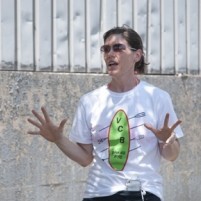Eyebeam Research Resident (2016):
Investigating relationships between labor and leisure, and the built and the natural environment, Nancy Nowacek actively engages with the world around her. She makes task-based encounters between people, spaces, and things.
Research-based, her practice is shaped by observation of, dissatisfaction with, and great optimism for the world around her. Her work examines the relationship between late capital post-industrial time sense and body sense, where physical anatomy has been surpassed by man-made machines as useful—or valuable—technology.
Projects Nowacek worked on over the years supported in part by Eyebeam
The Bridge (2012 – 2016)
The Bridge is political advocacy in the form of a proposal for a floating sculpture. The proposal—and its public research and development—is an act of reclamation of New York City’s waterways as public space.
It was designed as a temporary floating pedestrian bridge for passage between Brooklyn and Governors Island. Inspired by Walt Whitman’s report of farmers once walking their cows across Buttermilk Channel at low tide, the project aims to reconnect New Yorkers to their waterways, reclaim the waterfront step by step, helping New Yorkers gain agency over their bodies in relation to the water, a necessity in the new reality of living in a sinking city.
PROJECT CREDITS
Lead Advisors
Jessica Healy: Trustee, Van Alen Institute; Project Director, US Pavilion Expo Milano 2015; Associate Director, BMW Guggenheim Lab
Josh Rosenbloom: Real Estate Developer; Historian; Director of Off-Site Projects, National 9/11 Memorial; Director of City Operations, Lower Manhattan Construction Command Center and Lower Manhattan Development Corporation
Jonathan Marvel: Principal and Founder, Jonathan Marvel Architects PLLC
Design: Braden Caldwell
Public Relations: Monica Schaffer
Grant Funding: Beth Galinsky
Engineering: Thornton Tomasetti Inc. (structural); Glosten (marine)
Legal: DLA Piper LLP (US); Stroock & Stroock & Lavan LLP
Institutional Support: Lower Manhattan Cultural Council, Recess, Sharpe-Walentas Studio Program, Eyebeam, Fractured Atlas
Face Me (2015 – 2016)
Face Me is an open-source library created for the SketchUp Warehouse to integrate real people doing real things into the architectural design process.
SketchUp is free architectural design software used commonly in education and by young designers and hobbyists alike. It is entry-level software supported by a global community who supplies tutorials and assets to its open source library, the Warehouse.
Because SketchUp caters to a wider range of designers, it supplies a human figure—a “Face Me Component” for scale, dutifully standing at ease at the 0,0,0 coordinates. With every new version of the software, the figure changes, but so far has more often than not taken the form of a white male, aged 25-50, in casual Friday clothing, embedding heteronormative male politics into the fabric of every design project. These figures become the unspoken subject for spatial design, and the templated population expressed in final renderings.
The library’s diverse series of bodies represents the spectrum of bodies and activities unseen or unrepresented in spatial design. As potential Face Me Components and figures for building renderings, they challenge the values and beliefs that predominate the field. Students of architecture and practicing architects are invited to contemplate and use these open-source figures towards more inclusive constructed environments.
Eyebeam Project Resident (2015):
Nowacek was featured in an Eyebeam group exhibition – Reversing Art and Technology: Outside/In
Outside/In showcases the work of Mattia Casalegno, Torkwase Dyson, and Nancy Nowacek.
Lines not only demarcate, they reveal intimacies between that which is bounded and its complement. This exhibition highlights three artists whose work explores the porousness between the outside and inside, by examining how digital and other technological means tend to re-map spaces, both inner and outer. The sculptural installations of Mattia Casalegno, Torkwase Dyson, and Nancy Nowacek diagram the subtle ways these re-mappings occur.
Casalegno builds frames which integrate live webcam exchanges between strangers. They examine radical transformations of social relations in emergent digital platforms. Dyson presents a wall that doubles as a research station, in which she will examine local histories, from Wall Street’s slave market to the Seaport’s trading docks to the Financial District’s banking power. Nowacek creates deconstructions of the built environment. She nestles contemplative screens into arrangements of rough construction materials.
These works by Eyebeam Residents are examples of technology in an expanded sense: they are physical and conceptual tools by which we navigate and ultimately transform our contexts. This show will be followed by an exhibition Inside/Out, opening mid-November, which further examines the intricate geometries that link technology, culture and society, focusing on the externalization of that which is hidden.
